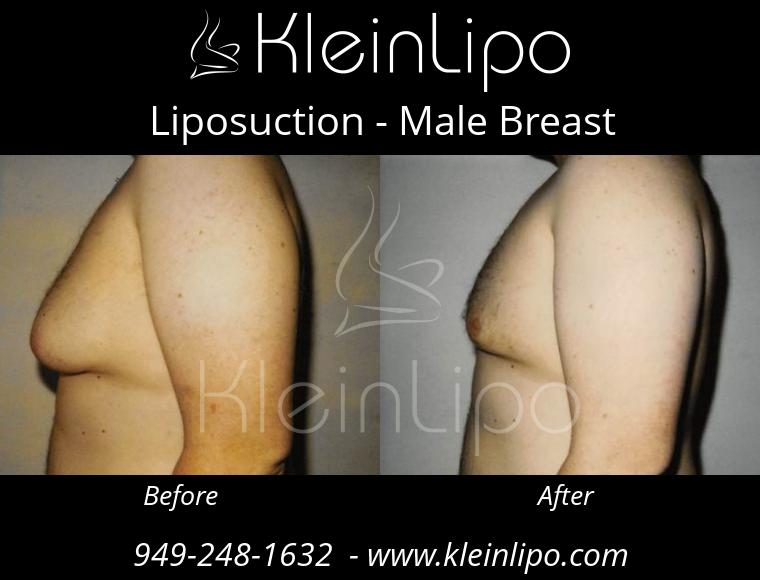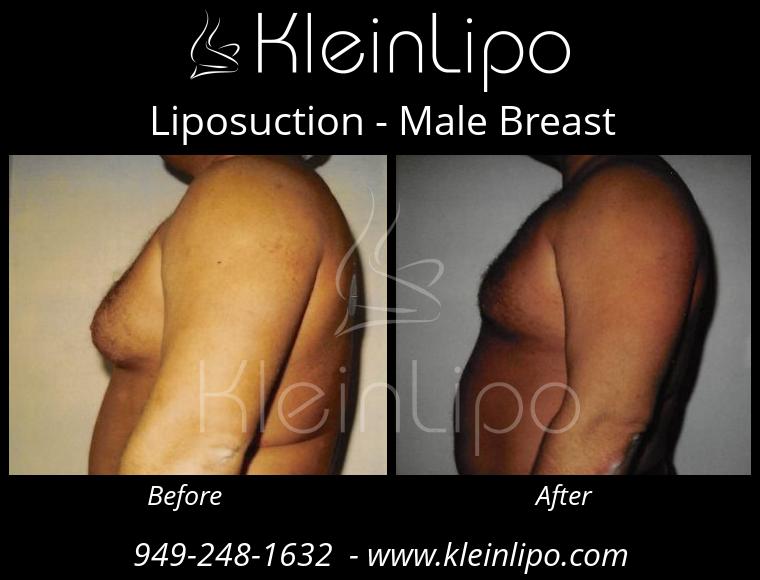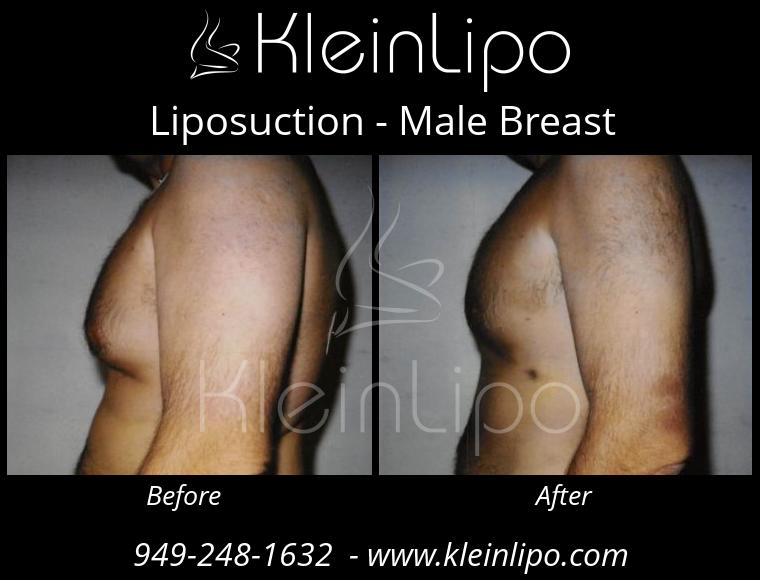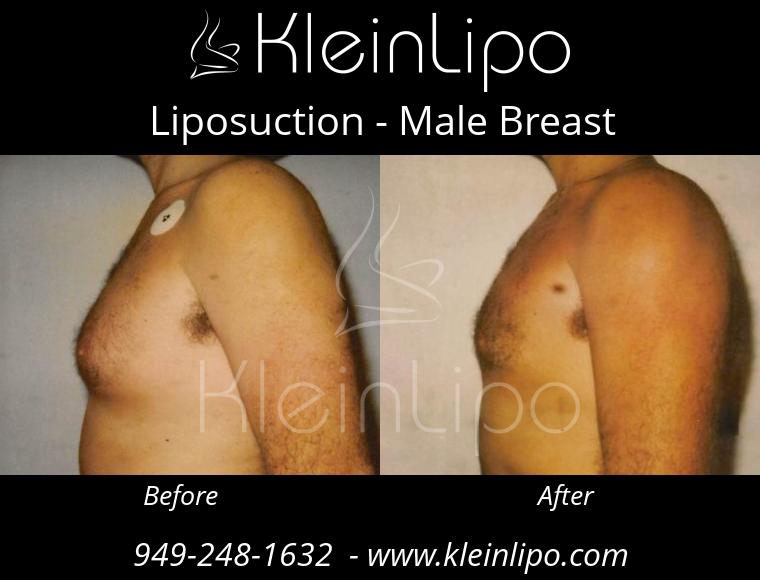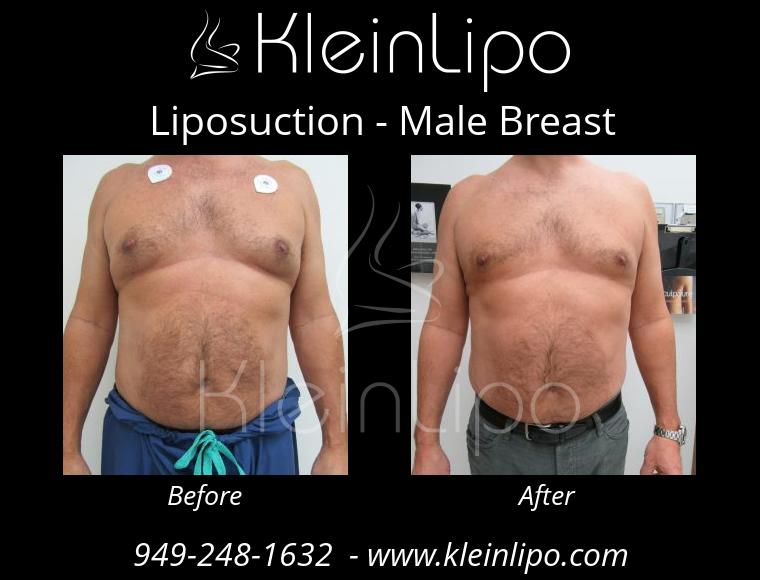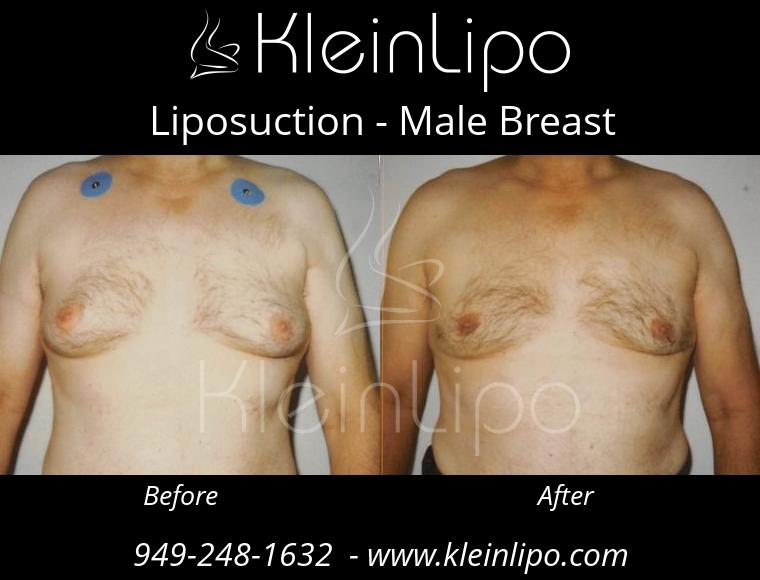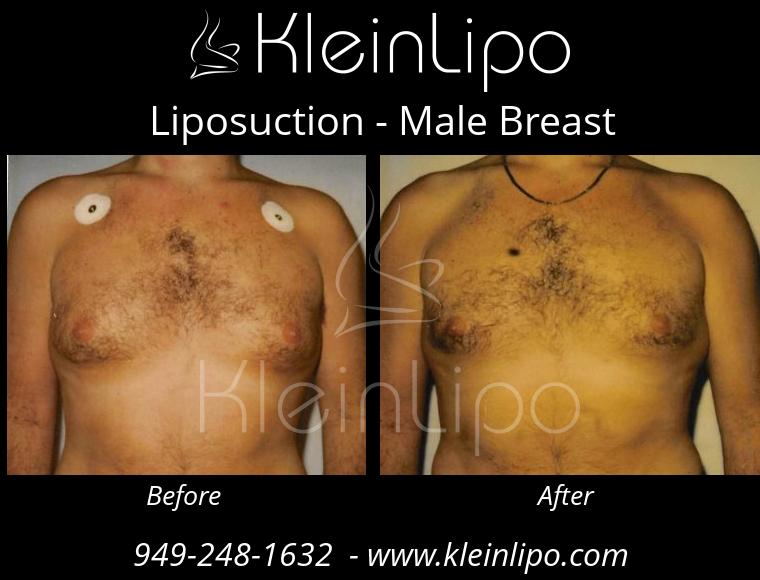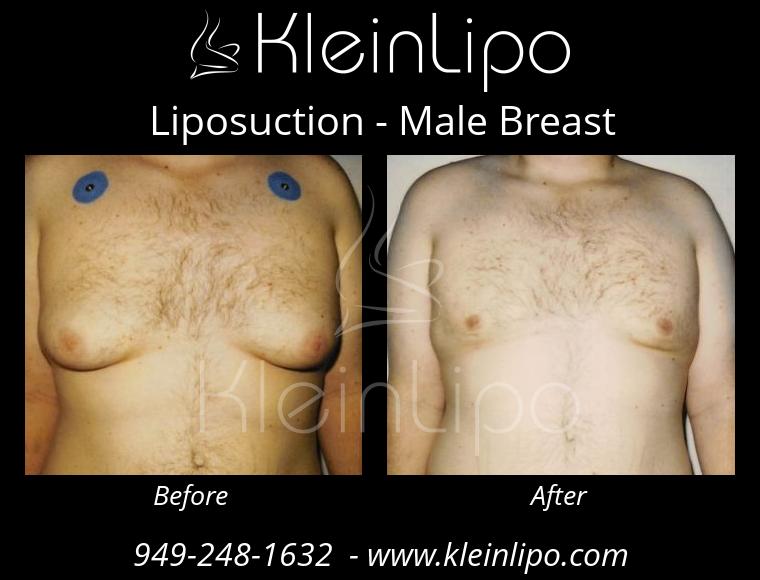Individual results may vary.
Tumescent Liposuction – Breasts, Male
The goal for liposuction of the male breast is simple: Improve the patient’s physical appearance by removing as much fat as possible while avoiding any damage to skin or muscles. Liposuction of the male breast is one of the four areas on men most commonly treated by liposuction. The other areas are the abdomen, flanks, and chin/cheek/jowls. Male patients with excessive fat in their breasts can expect significant improvement with tumescent liposuction.
The Normal Male Breast
The normal male breast contains both adipose (fat) tissue and fibrous glandular tissue. True breast tissue in males is typically a small localized lump located immediately under the nipple that is more firm than the surrounding fatty tissue. It is easy to remove fatty breast tissue by liposuction, but much more difficult to liposuction glandular tissue. Prospective patients should understand that it is sometimes difficult to accurately assess the relative amount of fat and true glandular breast tissue in a male breast. A routine mammogram may help in assessing the amount of dense glandular tissue located within the surrounding fatty tissue.
Pseudo-gynecomastia
Pseudo-gynecomastia is defined as an enlargement of male breast(s) caused by an excessive amount of fat tissue, but a normal amount of glandular breast tissue. Most male breasts that appear unusually large are the result of excessive fat. A slight but cosmetically undesirable degree of pseudo-gynecomastia probably occurs in a majority of men as they become older. Excessively fatty breasts are not uncommon in younger men who are relatively obese.
Pseudo-gynecomastia
Pseudo-gynecomastia is defined as an enlargement of male breast(s) caused by an excessive amount of fat tissue, but a normal amount of glandular breast tissue. Most male breasts that appear unusually large are the result of excessive fat. A slight but cosmetically undesirable degree of pseudo-gynecomastia probably occurs in a majority of men as they become older. Excessively fatty breasts are not uncommon in younger men who are relatively obese.
Pseudo-gynecomastia
Pseudo-gynecomastia is defined as an enlargement of male breast(s) caused by an excessive amount of fat tissue, but a normal amount of glandular breast tissue. Most male breasts that appear unusually large are the result of excessive fat. A slight but cosmetically undesirable degree of pseudo-gynecomastia probably occurs in a majority of men as they become older. Excessively fatty breasts are not uncommon in younger men who are relatively obese.
True Gynecomastia
This is defined as enlargement of male breast(s) caused by excessive glandular breast tissue. A true excess glandular breast tissue in men is not common. There are a number of distinct causes of gynecomastia including alcoholism, failure of the testicles to produce sufficient testosterone hormone, and many medications. Bilateral gynecomastia can also be associated with human immunodeficiency virus (HIV) infection, renal failure treated with hemodialysis, certain cancers such as testicular cancer, and adrenal corticosteroid secreting tumors. If a male has a single enlarged breast then one must consider the possibility of a true breast tumor. Any significant asymmetry of the male breasts, especially if there is a history of recent onset of asymmetric growth, should prompt the surgeon to consider a mammogram.
Drugs
Drugs that can cause gynecomastia include amiloride (Moduretic), amiodarone (Cordarone), amphetamines, anabolic steroids, antiandrogens (cyproterone), anticancer (cytotoxic) drugs, androgens, busulfan (Myleran), captopril (Capoten), cimetidine (Tagamet), clomiphene (Clomid), diazepam (Valium), diethylpropion (Tenuate), digitalis, domperidone, estrogens, isoniazid, ketoconazole (Nizoral), marijuana, methyldopa, metoclopramide, nifedipine (Procardia), nitrosourea, penicillamine, phenothiazines, phenytoin (Dilantin), reserpine, spironolactone (Aldactone), tricyclic antidepressants, vincristine.
Normal Temporary Gynecomastia
This occurs in 75% newborns due to maternal estrogen hormones that cross the placenta into the baby’s blood during the pregnancy. During puberty 60% of normal boys experience temporary breast enlargement that usually regresses within a few months.
Liposuction For Enlarged Male Breasts
This is most effective for pseudo-gynecomastia. For true gynecomastia, the breast tissue is dense and fibrous and therefore difficult to penetrate and remove with a liposuction cannula. Among normal healthy men there is a wide range of the relative amount of fatty tissue and glandular tissue found in the breasts. Most healthy men have a small amount of glandular tissue and a larger proportion of fatty tissue in their breasts. Microcannulas are effective in removing both breast tissue and fatty tissue from the normal male breast. Exceptionally dense glandular breast tissue may require surgical removal using a scalpel followed by a closure using stitches.
Liposuction Surgical Technique
Liposuction of the male breast is a well recognized procedure, however the technique and instrumentation has not been standardized. It has been our experience that smaller cannulas facilitate liposuction of male breast glandular tissue, and permit consistently outstanding results. Some surgeons use larger cannulas having an outside diameter (OD) of at least 4 mm. Many surgeons prefer to use prefer microcannulas having an inside diameter (ID) ranging from 16 gauge = 1.2 mm ID, 14 gauge = 1.8 mm ID, and sometimes a 12 gauge = 2.2 mm ID cannula. Some surgeons advocate excision male breast tissue with a scalple despite the relatively high incidence of scaring retraction and disfigurement.
Tumescent Liposuction by Local Anesthesia
Tumescent liposuction of the male breast can be accomplished totally by local anesthesia. After gently injecting local anesthesia into selected areas of the skin overlying the breasts, multiple 1.5 mm adits (punch biopsy holes) are made. Then a large volume of tumescent local anesthesia is injected into the breasts. The resistance of glandular breast tissue to penetration by a microcannula can be reduced by infiltrating a large volume of tumescent local anesthesia. The smaller the cannula diameter, the easier it can penetrate the dense tissues. Short 5 cm long 16 gauge cannulas are ideal of initiating liposuction within the dense portion of the male breast.
Postoperative Care
After liposuction is completed, the adits allowed to remain open (they are not closed with sutures) in order to maximize drainage of blood-tinged tumescent anesthetic solution. This drainage is absorbed by HK Pads held in place by an spandex HK Breast-Torso Garment?. For additional compression, two 6-inch wide elastic binders are place on top of the HK Garment, over the breast to maximize compression. A unique feature of the HK garment is a pair of velcro strips (hooks) sewn onto the front and extending from the shoulders to the mid abdomen that prevent the elastic binders from slipping out of place. See Figure 6. This combination of compression devices allows an adjustable degree of compression that can be applied precisely over the entire liposuctioned-area. Adequate compression during the first 18 to 24 hours after surgery is necessary to prevent bleeding and excessive bruising.
Realistic Expectations
While it is not realistic to expect perfect results, most patients should expect a significant improvement. It is a good idea for patients to assume that they will only achieve a 50% improvement. In fact, most men will achieve more than a 50% improvement. However, if the patient would not be satisfied with a 50% improvement then perhaps that patient’s expectations are too high and a little unrealistic. In some men, there is not much room for improvement. For example, if a thin man has a minimal amount of excess fatty tissue in the breast, then the surgeon might tell the patient not to expect more than a 30 percent improvement. It is usually a good idea for the surgeon to provide the prospective an explicit written estimate of the relative degree of improvement that the male patient can realistically expect.
Potential causes of patient dissatisfaction include insufficient amount of tissue removed by liposuction, excessive scars, uneven or asymmetric results, and skin irregularities. Using microcannulas tends to minimize the risk for these problems.
Avoid Ultrasonic Assisted Liposuction (UAL)
Ultrasonic liposuction is much more dangerous than most patients and many surgeons realize. There have been major complications including potential infections, complete loss of overlying skin as a result of burns caused by heat generated by the ultrasound device, and even deaths that are the direct result of UAL. The initial published reports and descriptions of the benefits of UAL were overly optimistic and inaccurate. Subsequent to these publications, some patients of the authors of these articles encountered severe complications as the direct result of UAL. By failing to publish these unfavorable results, the authors have contributed to an unrealistic and overly optimistic reputation of UAL. In fact, because the is insufficient evidence that UAL is safe, the U.S. Food and Drug Administration (FDA) has refused to permit any company to sell an ultrasonic devise to be used for liposuction.

